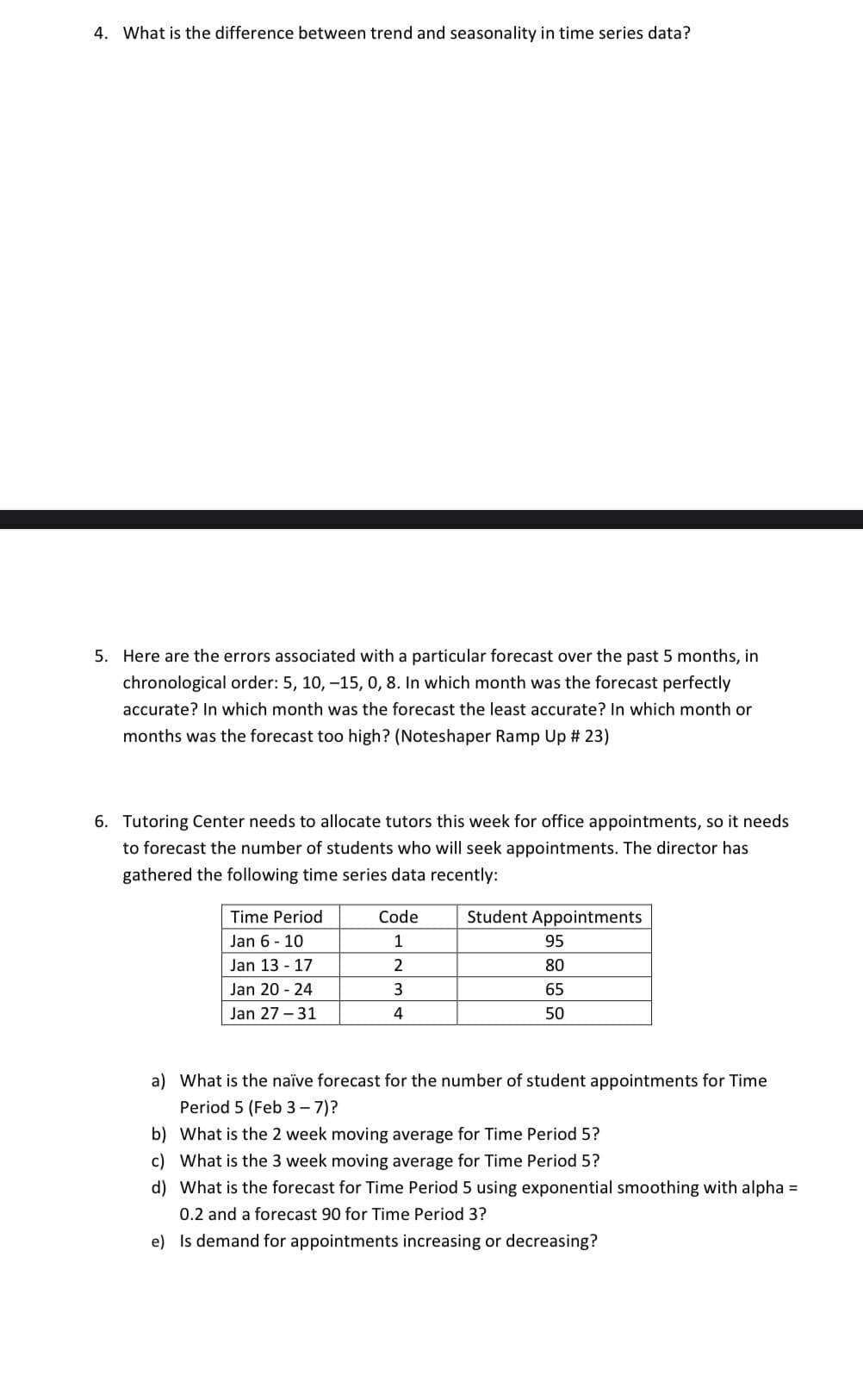4. What is the difference between trend and seasonality in time series data? 5. Here are the errors associated with a particular forecast over the past 5 months, in chronological order: 5, 10, -15, 0, 8. In which month was the forecast perfectly accurate? In which month was the forecast the least accurate? In which month or months was the forecast too high? (Noteshaper Ramp Up # 23) 6. Tutoring Center needs to allocate tutors this week for office appointments, so it needs to forecast the number of students who will seek appointments. The director has gathered the following time series data recently: Time Period Code Student Appointments Jan 6 - 10 Jan 13 - 17 95 2 80 Jan 20 - 24 3 65 Jan 27 – 31 4 50 a) What is the naïve forecast for the number of student appointments for Time Period 5 (Feb 3– 7)? b) What is the 2 week moving average for Time Period 5? c) What is the 3 week moving average for Time Period 5? d) What is the forecast for Time Period 5 using exponential smoothing with alpha = 0.2 and a forecast 90 for Time Period 3? e) Is demand for appointments increasing or decreasing?
4. What is the difference between trend and seasonality in time series data? 5. Here are the errors associated with a particular forecast over the past 5 months, in chronological order: 5, 10, -15, 0, 8. In which month was the forecast perfectly accurate? In which month was the forecast the least accurate? In which month or months was the forecast too high? (Noteshaper Ramp Up # 23) 6. Tutoring Center needs to allocate tutors this week for office appointments, so it needs to forecast the number of students who will seek appointments. The director has gathered the following time series data recently: Time Period Code Student Appointments Jan 6 - 10 Jan 13 - 17 95 2 80 Jan 20 - 24 3 65 Jan 27 – 31 4 50 a) What is the naïve forecast for the number of student appointments for Time Period 5 (Feb 3– 7)? b) What is the 2 week moving average for Time Period 5? c) What is the 3 week moving average for Time Period 5? d) What is the forecast for Time Period 5 using exponential smoothing with alpha = 0.2 and a forecast 90 for Time Period 3? e) Is demand for appointments increasing or decreasing?
Practical Management Science
6th Edition
ISBN:9781337406659
Author:WINSTON, Wayne L.
Publisher:WINSTON, Wayne L.
Chapter13: Regression And Forecasting Models
Section13.7: Exponential Smoothing Models
Problem 25P: The file P13_25.xlsx contains the quarterly numbers of applications for home mortgage loans at a...
Related questions
Question
100%

Transcribed Image Text:4. What is the difference between trend and seasonality in time series data?
5. Here are the errors associated with a particular forecast over the past 5 months, in
chronological order: 5, 10, -15, 0, 8. In which month was the forecast perfectly
accurate? In which month was the forecast the least accurate? In which month or
months was the forecast too high? (Noteshaper Ramp Up # 23)
6. Tutoring Center needs to allocate tutors this week for office appointments, so it needs
to forecast the number of students who will seek appointments. The director has
gathered the following time series data recently:
Time Period
Code
Student Appointments
Jan 6 - 10
95
Jan 13 - 17
80
Jan 20 - 24
65
Jan 27 – 31
4
50
a) What is the naïve forecast for the number of student appointments for Time
Period 5 (Feb 3– 7)?
b) What is the 2 week moving average for Time Period 5?
c) What is the 3 week moving average for Time Period 5?
d) What is the forecast for Time Period 5 using exponential smoothing with alpha =
0.2 and a forecast 90 for Time Period 3?
e) Is demand for appointments increasing or decreasing?
Expert Solution
This question has been solved!
Explore an expertly crafted, step-by-step solution for a thorough understanding of key concepts.
This is a popular solution!
Trending now
This is a popular solution!
Step by step
Solved in 2 steps

Recommended textbooks for you

Practical Management Science
Operations Management
ISBN:
9781337406659
Author:
WINSTON, Wayne L.
Publisher:
Cengage,

Contemporary Marketing
Marketing
ISBN:
9780357033777
Author:
Louis E. Boone, David L. Kurtz
Publisher:
Cengage Learning

Marketing
Marketing
ISBN:
9780357033791
Author:
Pride, William M
Publisher:
South Western Educational Publishing

Practical Management Science
Operations Management
ISBN:
9781337406659
Author:
WINSTON, Wayne L.
Publisher:
Cengage,

Contemporary Marketing
Marketing
ISBN:
9780357033777
Author:
Louis E. Boone, David L. Kurtz
Publisher:
Cengage Learning

Marketing
Marketing
ISBN:
9780357033791
Author:
Pride, William M
Publisher:
South Western Educational Publishing